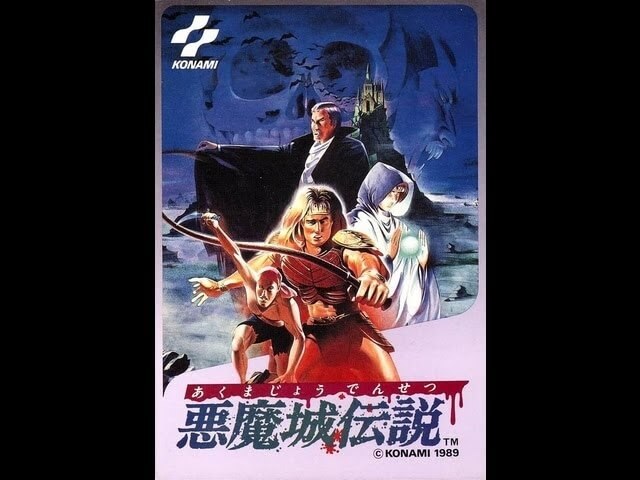Dracula might be dead, but life goes on after Castlevania III’s bittersweet ending

Three things happen at the end of Castlevania III: Dracula’s Curse in quick succession. First, you unclench your anus, having survived the grueling last level, a two-part gauntlet of brutal jumps, fire-breathing dragon heads, and, ultimately, Dracula himself. Second, the vampire’s castle, as it always does at the end of these journeys, crumbles to the ground leaving a jagged foundation on the horizon. Finally, Sypha Belnades lets her hair down. These three beats embody Castlevania as a series: reflex-shredding action wrought in purple music and thick color followed by an artful release. That’s what Castlevania is. But it’s the vampire hunter shaking out her hair that tells us what it’s about. We kill the monster, but then we keep on living.
Sypha Belnades, one of three companions that can join main character Trevor Belmont on his quest to kill Dracula, has a lot going on. Castlevania III’s manual describes her as “the Mystic Warlord of Warakiya, a vampire hunter who walks quickly and carries a big stick.” Beyond the mangling of what’s almost certainly supposed to be Wallachia, the Romanian region where the real life Vlad Dracul lived back when, it makes Sypha sound like a real badass. The drawings of her on the cover and in the manual help, too. She’s cloaked and throwing fire from her bare hands. She’s also notably androgynous. All we can see is a sharp chin and bouffant bangs, a cloaked wizard version of Diamond Dogs David Bowie. In fact, the text refers to Sypha as “he” multiple times.
Despite her obvious strength, Sypha is clearly having a rough go of it when you meet her in the game. In the third stage, a swampy forest with weird statues waiting in its center, you’ll have to fight a stone cyclops. Fell him, and lightning strikes one of the statues, releasing an imprisoned Sypha (Syfa according to the game text) back into the world. “I will follow you if you need my help,” she says. The game then asks, “What will you do: Take him with you? Leave him behind?”
Based on what we know up front, Sypha sounds useful in an assault on a castle that’s a manifestation of pure, supernatural evil, but she is a risk. Her fire spell is powerful but has limited ammunition, and she’s extra vulnerable thanks to the short reach of her staff. Getting through the game’s vicious final stage requires judicious use of both Trevor and Sypha. The reach and rhythm of Trevor’s whip is crucial for knocking out fleet skeletons and fiery bone towers, but it’s Sypha who’s essential for bringing down Dracula himself. His second form is a floating mass of poison-vomiting heads and the third a dragon that can only be damaged on his head. Sypha’s fire spell is the easiest way to demolish both. The hard year comes to an end with her new companion, and the castle crumbles. Then she lets her hair down.
“Syfa, the vampire killer has had a bad life,” the game says, understating how much it probably sucks to get trapped inside a statue. “But since she met Trevor she is beginning to feel more comfortable with herself.” On screen, he reaches out an arm, and she rests her head on his shoulder. The scene’s romantic undertones are ambiguous. They don’t kiss, they don’t hug. Trevor and Sypha physically connect in the moment. More clear is that Sypha has apparently been hiding her gender. The manual and the game itself referred to her as a man while the character concealed her long hair until the fight was over. She’s hunted the vampire, and with a friend in tow, she’s comfortable with showing her true self, at least in front of him.
All of the endings in Dracula’s Curse are mixed victories. If you play through as Trevor solo, he’s alone at the end of his journey. If you play through with Grant, the wall-climbing pirate, Dracula’s gone but Grant’s family is still dead. Play through with Alucard, Dracula’s son, and you have to face the fact that not only are you complicit in patricide but your new friend, at best, has to live forever, eternally secluded from humanity or, at worst, is the next creature Trevor and his Belmont descendants will have to hunt down. And while this is Castlevania III, it’s also explicitly a prequel, and all of those bittersweet endings are made even more bitter by our knowledge that Dracula ultimately comes back again and again.
But the mixed nature of Sypha’s victory in Dracula’s Curse is what makes it beautiful and worth revisiting. It is in no way an ending, but a peak on the road. We don’t need the game to tell us Sypha’s had a hard life; we got to see a portion of it at its worst. No one wants to get stuffed inside a statue or fight monsters on a ghost ship or shoot fire in the face of disembodied heads. No one wants to have to hide who they are just to feel comfortable. And while she’s found new confidence thanks to the trust of a friend, we also know that her life isn’t going to stop being hard, whether that’s struggling with gender or the next time Dracula’s castle rumbles its way out of the ground. Life keeps going, so we keep fighting and take what victories we can, mixed as they may be.